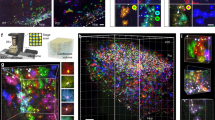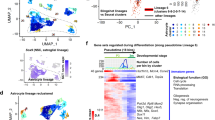Abstract
The shape of a neurone—the projection and branching pattern of axons and dendrites—appears to be determined by a combination of intrinisic and environmental influences1–5. We have previously shown that striatal target neurones influence the biochemical maturation of ascending mesencephalic dopamine (DA) cells in culture6,7, as well as the elongation rate of DA neuntes8. Using a similar approach in which the morphology of individual DA cells can be studied after 3H-DA uptake and autoradiography, we now report on in vitro neurone-glia interactions and show that glial cells exert a morphogenetic effect on DA neurones. Dopaminergic neurones from the mesencephalon were plated on glial monolayers prepared either from the striatal or the mesencephalic region of the embryonic brain. On mesencephalic glial cells the majority of DA neurones develop a great number of highly branched and varicose neuntes, whereas on striatal glia they only exhibit one long, thin and rather linear neurite. These results demonstrate that glial cells from two different brain regions have distinct properties which could be used to define neuronal polarity observed in vivo.
This is a preview of subscription content, access via your institution
Access options
Subscribe to this journal
Receive 51 print issues and online access
$199.00 per year
only $3.90 per issue
Buy this article
- Purchase on SpringerLink
- Instant access to full article PDF
Prices may be subject to local taxes which are calculated during checkout
Similar content being viewed by others
References
Solomon, F. Cell 16, 165–170 (1979).
Bray, D. J. Cell Biol. 56, 702–712 (1973).
Benfey, M. & Aguayo, A. J. Nature 216, 150–152 (1982).
Berry, M., McConnel, P. & Sievers, J. Curr. Topics devl Biol. 15, 67–101 (1980).
Shankland, P., Bently, D. & Goodman, C. S. Devl Biol. 92, 507–520 (1982).
Prochiantz, A., di Porzio, U., Kato, A., Berger, B. & Glowinski, J. Proc. natn. Acad. Sci. U.S.A. 76, 5387–5391 (1979).
di Porzio, U., Daguet, M.-C., Glowinski, J. & Prochiantz, A. Nature 288, 370–373 (1980).
Denis-Donini, S., Glowinski, J. & Prochiantz, A. J. Neuroscience 3, 2292–2299 (1983).
Bjorklund, A. & Lindvall, O. Brain Res. 83, 531–537 (1975).
Fallon, J. H., Riley, J. N. & Moore, R. Y. Neurosci. Letters 7, 157–162 (1978).
Berger, B. et al. Neuroscience 7, 193–205 (1982).
Lazarides, E. Nature 283, 249–256 (1980).
Prochiantz, A., Delacourte, A., Daguet, M.-C. & Paulin, D. Expl Cell Res. 139, 404–410 (1982).
Sensenbrenner, M., Devilliers, G., Bock, E. & Porte, A. Differentiation 17, 51–61 (1980).
Lindsay, R. M., Barber, P. C., Sherwood, M. R. C., Zimmer, J. & Raisman, G. Brain Res. 243, 329–343 (1982).
Barde, Y. A., Edgar, D. & Thoenen, H. Proc. natn. Acad. Sci. U.S.A. 77, 1199–1203, (1980).
Lindsay, R. M. Nature 282, 80–82 (1979).
Adler, R. & Varon, S. Devl Biol. 86, 69–80 (1981).
David, S. & Aguayo, A. J. Science 214, 931–933 (1981).
Banker, G. A. Science 209, 809–810 (1980).
Touzet, N. & Sensenbrenner, M. Devl Neurosci. 1, 159–163 (1978).
Patterson, P. H. & Chun, L. L. Y. Proc. natn. Acad. Sci. U.S.A. 71, 3607–3610 (1974).
Patterson, P. H. & Chun, L. L. Y. Devl Biol. 56, 263–280 (1977).
Hemmendinger, L. M., Garber, B. B., Hoffman, P. C. & Heller, A. Proc. natn. Acad. Sci. U.S.A. 78, 1264–1268 (1981).
Author information
Authors and Affiliations
Rights and permissions
About this article
Cite this article
Denis-Donini, S., Glowinski, J. & Prochiantz, A. Glial heterogeneity may define the three-dimensional shape of mouse mesencephalic dopaminergic neurones. Nature 307, 641–643 (1984). https://doi.org/10.1038/307641a0
Received:
Accepted:
Issue Date:
DOI: https://doi.org/10.1038/307641a0



